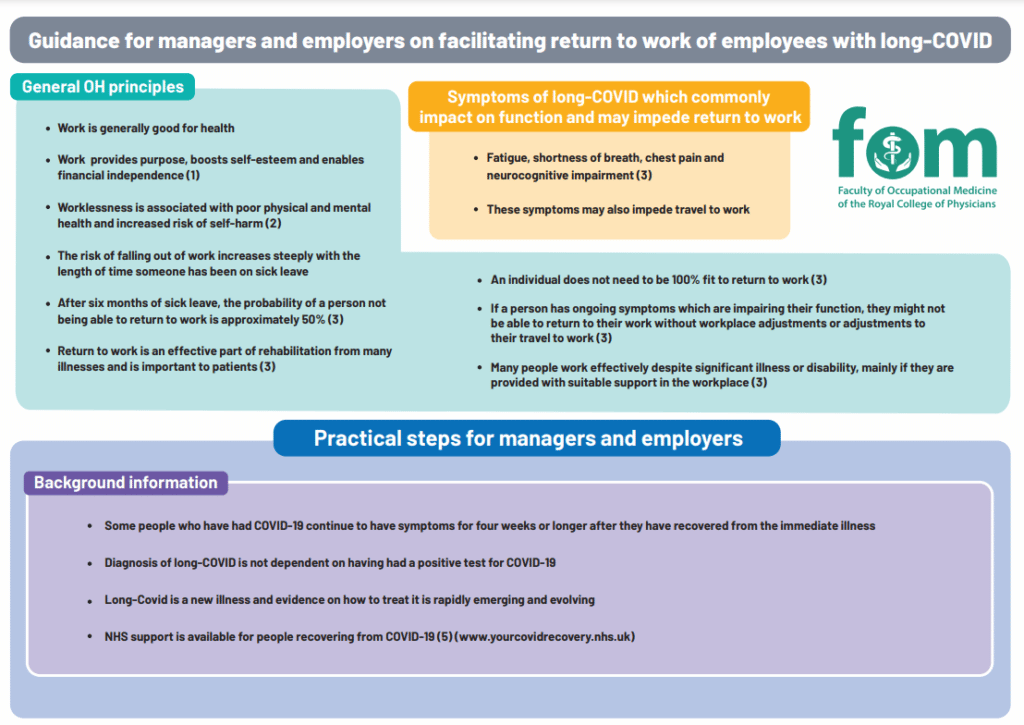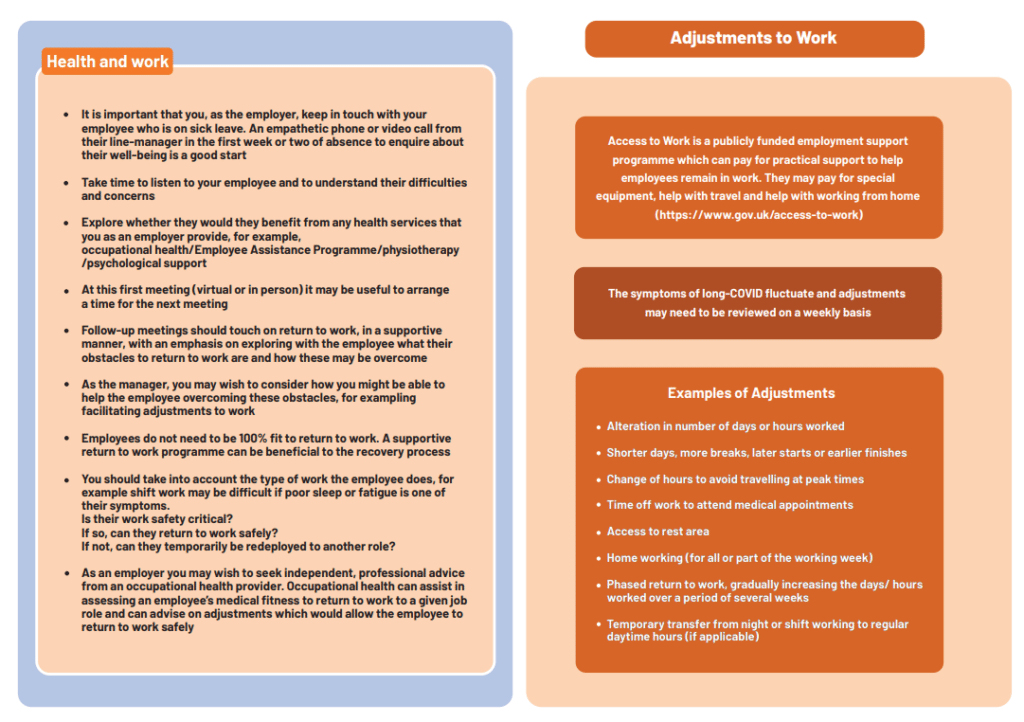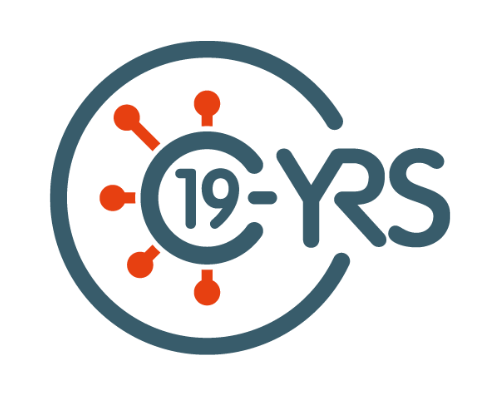Return to Work
Introduction
- 44% of those experiencing Long Covid reported a significant impact on their work – Office for National Statistics, 2021
- The largest global study of “Long Covid” to date has found that many of those suffering from ongoing illness after infection with Covid-19 are unable to return to work at full capacity six months later.
- Over 45% reported requiring a reduced work schedule compared with pre-illness and 22.3% said they were not working at the time of the study due to their health condition – Davis et al 2021 – Characterizing Long COVID in an International Cohort: 7 Months of Symptoms and Their Impact.
A word of reassurance: although recovery from COVID-19 can be slow, many people improve with time, and treatments are improving as more is known. Returning to work is part of the recovery even if it must be flexible or on a phased return at first.
With all this in mind, it makes sense for workers and employers to work together towards a return to work that is the most productive for all concerned.
Statistics
Taken from a study by Trades Union Congress on workers’ experiences of Long Covid:
- 52% of workers experienced poor treatment at work due to ‘Long Covid’
- 19% were asked by their employer about the impact of their symptoms
- 13% were asked whether they had Long Covid at all
- 18% were going through absence management/HR processes
- 5% felt they were ‘forced’ out of their jobs
- 9% had used up all of their sick leave due to Long Covid
Symptoms and Effects
- Fatigue/Extreme tiredness (90%)
- Breathlessness (70%)
- Reduced stamina/exercise tolerance/strength
- Problems with memory, planning, concentration, communication (“brain fog”) (72%)
- Difficulty sleeping/sleep disturbance
- Palpitations
- Dizziness and reduced balance
- Pain – muscle/joint (83%)
- Depression/Anxiety (32%)
- Headache
- Sensory Disturbance (tinnitus, earache, blurred vision)
- Nausea, diarrhoea, stomach aches, loss of appetite
- Changes to sense of smell or taste
- Fluctuating symptoms – boom/bust pattern
- Fatigue – Feeling tired/exhausted/weak
- Falling asleep at work – momentarily or for several minutes
- Weakness – reduced stamina/tolerance/physical strength
- Inability to cope with demands/schedule/ previous role
- Working at a slower pace
- Increased errors
- Slower reaction times (for example, to hazards arising in the workplace)
- Increased incidence of injuries
- Reduced motivation/interest in role/work
- Feeling emotional / reduced emotional capacity
- Irritability/lower tolerance levels
- Difficulty concentrating with frequent lapses of memory/attention
- Difficulty making clear decisions
- Difficulty processing/relaying information
- Inability to multi-task
- Difficulty following conversations/meetings/social interactions
- Pain/Headache
- Anxiety/Panic
- Sensory Intolerance (lights/sounds)
- 58% said they experienced difficulties with their memory whilst at work;
- 50% said they experienced difficulties with learning, understanding and concentrating, particularly when working in a desk-based role
- Other areas affected include: new learning, hazard perception, initiation of personal action, coping with social engagements and interactions, verbal communication and decision making.
Chronic Illness Inclusion, 2021
Absence and sickness due to Long-COVID
For some people, coronavirus (COVID-19) can cause symptoms that last weeks or months after the infection. This can be called ‘post-COVID-19 syndrome’, ‘long-tail COVID’ or ‘long COVID’. Long COVID symptoms could affect someone’s ability to work or cause them to take sickness absence.
The usual rules for sickness absence and sick pay will usually apply when someone is off work because of long COVID*. (*Long Covid does not trigger usual sickness policies for NHS staff so it doesn’t affect sickness record and pay etc.)
Employees should:
- Communicate the reason they are off work to their employer and provide regular updates in relation to their symptoms and expected return date
- Provide a sick note/fit note (and discuss how long you they are likely to be off work – if known).
If you are off work for longer, for example, due to Long COVID, you need to give some information to your manager and discuss:
- How long you have been advised to stay off work, and provide a ‘fit note’, also called ‘sick note’. As an employee you have a duty to inform your manager as soon as possible if you are off sick, to provide a ‘sick note’ and to give some idea of how long you will be off sick. Due to restrictions on face-to-face GP appointments, a ‘fit note’ may currently not be necessary and an NHS 111 email may be sufficient
- The reason you need to be off work. Something simple and general is enough, like “I have suspected COVID-19” or a “viral illness”. You are not required to give your manager any medical details. You can say as much or as little as you want
- When you should contact your manager to provide an update. If you intend to return to work, you should arrange a meeting with your manager beforehand. If you are still too unwell to work, you must produce another ‘sick note’. You can make contact via telephone, email, video link or face-to-face. You can agree with your manager which method
- That some people will have continuing symptoms such as fatigue for a few weeks, others may have effects of the infection which take longer to recover. Other common symptoms are fast heart rate, breathlessness, and pain. You may feel anxious or low in mood. If you are worried about any new symptoms you should contact your GP
- That Long COVID can have unusual patterns: relapses, phases with new, sometimes bizarre symptoms
- That an initially mild case can be followed by later severe problems that can impact markedly on day-today activities
- That Long COVID can last for many months
- That you may need help with accessing healthcare tests and scans that would speed a return to work.
Do not hold back from asking for this.
Sick notes and fit notes
Sick Note – 7 days off sick or less:
- Your employer should not ask for medical evidence that you’ve been ill.
- Instead, they can ask you to confirm that you’ve been ill. You can do this by filling in a form yourself when you return to work. This is called self-certification.
Fit Note – more than 7 days off sick:
- Your employer will usually ask for a fit note (or Statement of Fitness for Work) from a GP or hospital doctor. Fit notes are sometimes referred to as medical statements or a doctor’s note.
- Your doctor will assess you, and if they decide your health affects your fitness for work, they can issue a fit note and advise either that:
- You are “not fit for work”
- You “may be fit for work taking into account the following advice”
The information on your ‘fit note’ should be an agreement between you and the doctor (GP or hospital specialist) who writes it. Your health information is confidential to you, but it does help to give a simple explanation. In some jobs e.g. the NHS, writing COVID-19 on the ‘fit note’ helps to ensure that you are paid correctly during your absence.
Role of employers and legislation
- Employers should be aware that the effects of Long COVID can fluctuate. Employees may have good and bad days, and symptoms can be both physical and mental.
- If someone is off sick, they might feel isolated or need support to return to work.
- Keep in touch and remain in regular contact
- Have regular wellbeing conversations and highlight or offer employee support, wellbeing services, psychological support and medical services/tests
- Talk about ways to support them as they return to work where and when possible
- Refer to Occupational Health early on
- Consult with HR re return to work policies and processes (sickness absence, flexible working, health and safety)
- Recommend staff join Long Covid support groups and peer networks
- Signpost staff to GPs/Post-Covid Rehabilitation Clinics
Taken from a study by TUC on workers’ experiences of Long Covid:
- 52% of workers experienced poor treatment at work due to ‘Long Covid’
- 19% were asked by their employer about the impact of their symptoms
- 13% were asked whether they had Long Covid at all
- 18% were going through absence management/HR processes
- 5% felt they were ‘forced’ out of their jobs
- 9% had used up all of their sick leave due to Long Covid


Legislation
The Equality Act 2010 legally protects people from discrimination in the workplace and in wider society.
This means :
- Implementing or enhancing flexible working, reduced hours and/or adapting shifts to accommodate employees suffering from exhaustion so they can take rest breaks or naps as needed and plan their day and/or commute around their energy levels.
- Consider making changes to workstations for those suffering from joint and muscle pain so they can work more comfortably.
- Consider whether adjustments to the role would be appropriate, such as relaxing targets, even if this is on a short-term basis.
- Where an employee has lost confidence in their abilities as a result of having been off sick for a long period of time, it may be helpful to arrange for the employee to have a mentor if they wish or enquire whether they would benefit from some counselling until they have recovered their confidence.
- Under the law, a disability is a physical or mental impairment that has a ‘substantial and long-term’ negative effect on a person’s ability to do normal day-to-day activities.
- ‘Long term’ means the impairment has lasted or will last for at least 12 months OR can come and go or is likely to last for the rest of the person’s life
- It is currently understood that Long Covid can last or come and go for several months. The effects of long COVID could also cause other impairments.
- Studies have shown that 29 per cent of people with Long Covid experience symptoms for 12 months or more.*
*This length of time is significant because in order to be protected under the disability provisions of the Equality Act 2010, a person has to have a condition that has a substantial and long-term impact on their ability to do normal day-to-day activities. Long term is usually taken to mean 12 months or more.
- If an employer feels the employee is not able to do their work or is taking a lot of absence due to Long Covid, they should see if they can do anything to help. For example, a further occupational health assessment to find out if more support is needed.
- They should make sure they have done everything they can before considering a capability procedure.
If an employer dismisses an employee without first carrying out a full and fair disciplinary or capability procedure, the employee could make a claim of unfair dismissal to an employment tribunal.
- As well as disability, employers must to be careful to avoid other types of discrimination when considering Long COVID.
- Long COVID has been found to more severely affect older people, ethnic minorities and women.
Returning to work
When day to day activity levels are reasonably consistent
When a daily routine has been established.
When bad days are less severe and less frequent
When there is an understanding in relation to individual triggers and appropriate strategies are in place to manage them.
When the person feela well enough in themselves (even if activity levels are significantly less than before)
When medical clearance has been provided, particularly if the role involves heavy lifting or exertion, or it is a safety critical role
Liaise with their GP
Liaise with Occupational Therapy/Long Covid Clinic
Complete a Return to Work Action Plan (or NHS Health Passport)
Meet with employer/manager
Undergo a full occupational health assessment
Seek representation from a Trade Union, if necessary
Click here to visit the SOM site to download a leaflet detailing this process further.
A phased return to work offers workers the opportunity to return to work at an earlier stage of recovery from illness by allowing them to work reduced hours with modified duties based on a structured return to work plan.
What to expect: A phased return to work involves an arrangement between you and your employer. It allows you to come back to work on one or all of the following conditions:
Reduced hours.
Lighter duties.
Alternative duties.
Environmental/workplace location alterations
Reasonable adjustments.
You may need an extended phased return:
With Long Covid, phased returns may need to extend beyond the typical 2-6 week period, extended returns have no fixed time frames. GPs can recommend an extended phased return within the Fit Note.
Extended = Open-ended with no fixed time frame
An extended phased return allows a person to:
Build endurance to work-related tasks
Learn how to transfer symptoms management strategies to the workplace
Have sufficient time for recovery
Return to work sooner
Return to work more sustainably
Facilitate continued recovery
A ‘reasonable adjustment’ is a change to remove or reduce the effect of:
an employee’s disability so they can do their job
a job applicant’s disability when applying for a job
The reasonable adjustment could be to:
the workplace
the ways things are done
get someone to help the employee or job applicant
What is ‘reasonable’ will depend on each situation. The employer needs to consider carefully if the adjustment:
will remove or reduce the disadvantage for the person with the disability
is practical to make
is affordable by the employer or business
could harm the health and safety of others
Managing workloads, tasks and break planning
If you are struggling to manage more complex problem solving; background noise and small distractions might quickly drain your levels and make you much less productive. Finding a quiet space to work in, or allowing home working, is likely to help. This might relate to all of your work- or just for more demanding tasks.
When you first return to work, in the initial stages, you should try to allocate work that will allow you to maintain an element of control, and where there is a degree of predictability. This will allow you to implement symptom management strategies and ensure that you do not take on more than you are capable of.
Starting off with shorter working days will allow you to gradually increase your stamina to work-related tasks. Even if your role is not physically challenging- the cognitive and emotional demands of a working day are likely to be difficult.
When you first return to work, it is normal for you to experience an extended recovery as you adapt and adjust. Working non-consecutive days allows time for recovery and is likely to maximise efficiency during each shift.
Poor sleep quality can significantly affect your level of energy and ability to complete work tasks. If you were is struggling with sleep, consider whether early shifts, and night shifts, should be avoided as you ease back in.
A shift pattern which allows you to keep to a reasonably consistent routine might also help.
Frequent breaks are likely to be beneficial in almost every case. Breaks allow for a short periods of restoration- which can help you to manage fatigue, pain and anxiety. It will mean that your overall recovery time after the shift is shorter, and you are likely to be more productive at work- especially towards the end of your working day. It is important to continue to allow breaks when the staff member returns to consecutive days.
Breaks can be at fixed points during the day, you might need a short break where you can sit and rest. Others might be able to continue to work- but need to do so in sitting. Some staff might need time to complete stretches or breathing exercises. The point of a break is to allow the staff member to feel more energized- and this is likely to mean different things to different people.
For those managing post-viral fatigue, a balance between activity and rest is required for effective pacing.
There are likely to be certain tasks that are more challenging than others.
These are likely to include:
- Moderate to heavy lifting and/or repetitive lifting
- Elements of manual handling
- Spending prolonged periods of time walking or standing
- Moving at a very fast pace
- Lots of talking – face to face or on the phone
- Sustained periods of concentration or very frequent task switching
- Being in very busy environments
Consider how you could initially minimise or remove exposure to these tasks. Doing so may improve your overall endurance to work; support recovery and reduce the risk of additional sickness absence.
Summary of top tips
- Stay off work until you feel well enough.
- Communicate with your employer about your health status.
- If you feel fit to return to work, consult your health care professional and employer’s occupational health service to obtain clearance to recommence duties.
- Review your work responsibilities and assess whether you would be able do the full role or only part of the role.
- Discuss with your employer a return-to-work plan that involves a gradual increase in your duties over a period (otherwise called a “phased return to work”) and is regularly reviewed. This can help prevent relapse and further absence. When you return, adjustments can be made to your work pattern, such as your start and finish times, working from home or taking up lighter tasks to begin with.
- Your employer should be supportive in this phased return to work process, which can take weeks or months depending on the nature of your symptoms and the nature of your work.
- If you’re unable to meet the requirements of your role, you could consider a change of duties or redeployment.
- If you think your medical condition is likely to affect your work in the long term, consult your health care professional and employer so that necessary adjustments can be made based on national policies and legal requirements.
Resources
Leeds Partnership Trust’s Returning to an existing job PDF Booklet
Cambridgeshire and Peterborough’s A guide to work PDF Booklet
WHOs Support for rehabilitation: selfmanagement after COVID-19-related illness PDF Booklet – Page 23
Cambridge and Peterborough Post Covid Service Video on ‘Vocational Rehabilitation’
Disclaimer: This video has been created for a Cambridge and Peterborough audience so please ignore any references to the local service, instead use the content appropriately for your own care.
Return to Work Videos - University Hospitals of Derby and Burton NHS Trusts
Managing COVID-19 Related Symptoms During Sickness Absence.
Return to Work Rehabilitation.
Managing On-going COVID-19 Related Symptoms in the Workplace.
Supporting Staff with On-going COVID-19 Related Symptoms to Return to Work : Advice for Managers.
Thank you to the contributors for this section




